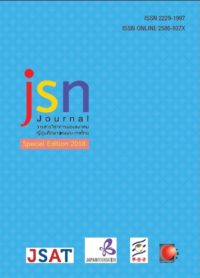Sociological Perspective on Way of Japanese Consumption in Thai Society
Main Article Content
Abstract
trend of studies in the field of way of Japanese food consumption in Thailand are not widely conducted and limited in several ways. Previous researches mainly focus on Japanese food’s consumption attitude, decision, factors and consumption behavior. Previous researches give the consistency result. This trend of study cannot expand or give the new concept to clearly reflect the recent phenomenon of Japanese food consumption in Thailand. The study about the way of Japanese food consumption related to media and cultural consumption should be considered and focused in order to give broader perspective. This paper also
reveals that results of previous studies indicated that the conditions of nature of consumers, products, price, channel of words Way of Consumption, Japanese Food, Culture, Consumption of Signs Key Sociological Perspective on Way of Japanese Consumption in Thai Society Keeratiporn Jutaviriya distribution, marketing promotion, staff, environment and culture are related to way of Japanese consumption in Thai society. All
of the conditions reflect the way of thinking and trend of study in the field of life style in Japanese consumption in the modernity. However, these results show that previous studies are not focused on the social structure and power of individualism which in fluencing on people’s consumption in the society. Consumers, themselves create their own life style called Consumption of Signs. This kind of life style reflects the reality of individualism and powerful structure over the consumer’s decision. Further studies on way of the consumers as the agency in fluencing on way of consumption are therefore suggested in order to clearly reveal the reality occurring in the modern society.
Article Details
ข้อความและข้อคิดเห็นต่างๆ ในบทความเป็นของผู้เขียนบทความนั้นๆ ไม่ใช่ความเห็นของกองบรรณาธิการหรือของวารสาร jsn Journal
References
กนกพรรณ สุขฤทธิ์. (2557). ส่วนประสมการตลาดบริการและพฤติกรรมการใช้บริการร้านอาหารญี่ปุ่นย่าน Community Mall ของผู้บริโภคในกรุงเทพมหานคร.สารนิพนธ์ปริญญาบริหารธุรกิจมหาบัณฑิต สาขาวิชาการตลาด มหาวิทยาลัยศรีนครินทรวิโรฒ.
กาญจนา แก้วเทพ. (2541). การวิเคราะห์สื่อ: แนวคิดและเทคนิค.กรุงเทพฯ: อินฟินิตี้เพรส.
กิตติภพ สงเคราะห์. (2555). ปัจจัยที่มีผลต่อพฤติกรรมการเข้าใช้บริการร้านอาหารญี่ปุ่นของผู้บริโภคในจังหวัดปทุมธานี. สารนิพนธ์บริหารธุรกิจมหาบัณฑิต, สาขาวิชาการตลาด, คณะบริหารธุรกิจ, มหาวิทยาลัยเทคโนโลยีราชมงคลธัญบุรี.
กีรติพร ศรีธัญรัตน์. (2553). “สินค้าวัฒนธรรมญี่ปุ่นกับวัฒนธรรมลูกผสมในไทยภายใต้กระแสโลกาภิวัตน์” เอกสารหลังการประชุมวิชาการระดับชาติของเครือข่ายญี่ปุ่นศึกษาในประเทศไทยครั้งที่ 3 สังคมศาสตร์. ขอนแก่น: คณะกรรมการเครือข่ายญี่ปุ่นศึกษาในประเทศไทย.
จิตรลดา ฟักป้อม. (2556). การตัดสินใจเลือกใช้บริการบุฟเฟ่ต์อาหารญี่ปุ่นในเขตกรุงเทพมหานครและปริมณฑล.สารนิพนธ์บริหารธุรกิจมหาบัณฑิต, โครงการบริหารธุรกิจมหาบัณฑิต, มหาวิทยาลัยรามคําแหง.
ชนสรณ์ โตกราน. (2551). พฤติกรรมการบริโภคอาหารญี่ปุ่นของผู้บริโภคในเขตอําเภอเมืองจังหวัดชลบุรี. วิทยานิพนธ์บริหารธุรกิจมหาบัณฑิต, บัณฑิตวิทยาลัย, มหาวิทยาลัยศรีปทุม วิทยาเขตชลบุรี.
ชนิดา เสถียรธนากร. (2551). คุณค่าตราสินค้าและทัศนคติด้านผลิตภัณฑ์ที่มีความสัมพันธ์กับพฤติกรรมของผู้บริโภคที่มีต่อภัตตาคารอาหารญี่ปุ่นฟูจิในเขตกรุงเทพมหานคร.สารนิพนธ์บริหารธุรกิจมหาบัณฑิต, สาขาวิชาการจัดการ, มหาวิทยาลัยศรีนครินทรวิโรฒ.
นัฐพล จํากําจร. (2558). อิทธิพลของสวนประสมทางการตลาดบริการคุณภาพการบริการและภาพลักษณ์ของแบรนด์ต่อการตัดสินใจเลือกร้านอาหารบุฟเฟต์ญี่ปุ่นในกรุงเทพมหานคร.สารนิพนธ์บริหารธุรกิจมหาบัณฑิต, มหาวิทยาลัยกรุงเทพ.
โนริยูกิ ซูซูกิและคณะ. (2553). “การบริโภคสินค้าวัฒนธรรมญี่ปุ่นในไทยสังคมไทยภายใต้กระแส- Japanization” เอกสารหลังการประชุมวิชาการระดับชาติของเครือข่ายญี่ปุ่นศึกษาในประเทศไทยครั้งที่ 3 สังคมศาสตร์.ขอนแก่น: คณะกรรมการเครือข่ายญี่ปุ่นศึกษาในประเทศไทย.
ปัญญดา บุญสิน. (2551). ปัจจัยที่มีความสัมพันธ์กับพฤติกรรมการบริโภคอาหารญี่ปุ่นฟูจิในห้างสรรพสินค้าในเขตกรุงเทพมหานคร.สารนิพนธ์ศิลปศาสตรมหาบัณฑิต, สาขาวิชาการจัดการภาครัฐและภาคเอกชน, บัณฑิตวิทยาลัย, มหาวิทยาลัยศิลปากร.
มัทวัน พยัคฆนันท์. (2557). การตัดสินใจเลือกใช้บริการและความต้องการปัจจัยส่วนประสมทางการตลาดของผู้บริโภคร้านโคอุนอินดี้. สารนิพนธ์คหกรรมศาสตรมหาบัณฑิต, สาขาวิชาคหกรรมศาสตร์,คณะเทคโนโลยีคหกรรมศาสตร์, มหาวิทยาลัยเทคโนโลยีราชมงคลพระนคร.
รัตนา โภคาศิริสิน. (2557). ปัจจัยที่มีอิทธิพลต่อการเลือกใช้บริการร้านอาหารญี่ปุ่นในซอยทองหล่อ (สุขุมวิท 55) ของผู้บริโภคในเขตกรุงเทพมหานคร. วารสารวิชาการการตลาดและการจัดการ มหาวิทยาลัยเทคโนโลยีราชมงคลธัญบุรี. 1(1), 114-123.
วราภรณ์ เทียนเงิน. (2559). ส่องตลาดอาหารญี่ปุ่น “ไทย” ใหญ่สุดในอาเซียน.โพสต์ทูเดย์ดอทคอม. สืบค้นเมื่อวันที่ 12 ส.ค.2559 จาก http://www.posttoday.com/biz/aec/scoop/438961
วุฒินันท์ สุนทรขจิต. (2551). ร้านอาหารญี่ปุ่นสมัยใหม่: พื้นที่การสื่อสารความหมายอัตลักษณ์และความเป็นญี่ปุ่น. วิทยานิพนธ์วารสารศาสตร์มหาบัณฑิต, สาขาสื่อสารมวลชน, มหาวิทยาลัยธรรมศาสตร์.
สมสมร สุขเณศกุล. (2550). การส่งเสริมการขายที่มีผลต่อการกลับมารับประทานอาหารญี่ปุ่นซํ้าของผู้บริโภคในเขตกรุงเทพมหานคร กรณีศึกษาอาหารญี่ปุ่น.วิทยานิพนธ์บริหารธุรกิจมหาบัณฑิต สาขาวิชาบริหารธุรกิจสําหรับผู้บริหาร บัณฑิตวิทยาลัย วิทยาลัยพาณิชยศาสตร์ มหาวิทยาลัยบูรพา.
อิงอร รัตตัญญู. (2553). พฤติกรรมการบริโภคอาหารญี่ปุ่นของผู้บริโภคในเขตเทศบาลนครหาดใหญ่ อําเภอหาดใหญ่ จังหวัดสงขลา.สารนิพนธ์ศิลปศาสตรมหาบัณฑิต, สาขาวิชาการจัดการธุรกิจเกษตร, มหาวิทยาลัยสงขลานครินทร์.
องค์การส่งเสริมการค้าต่างประเทศของญี่ปุ่น. (2556). รายงานการสํารวจผู้บริโภคในต่างประเทศเกี่ยวกับอาหารญี่ปุ่น.กรุงเทพฯ.
ASTV ผู้จัดการรายวัน. (2557). Japanese Restaurant: วัฒนธรรมที่มีมูลค่าทางเศรษฐกิจ.สืบค้นเมื่อวันที่ 12 ส.ค.2559 จาก http://www.manager.co.th/Weekend/ViewNews.aspx-?NewsID=9570000069788
Thai PR. (2552). แถลงข่าวเปิดตัว JRO องค์กรส่งเสริมร้านอาหารญี่ปุ่นในต่างประเทศสาขาประเทศไทยสัมมนาภายใต้หัวข้อสภาวะปัจจุบันและประเด็นปัญหาของอุตสาหกรรมผู้ประกอบการร้านอาหารญี่ปุ่น.สืบค้นเมื่อวันที่ 10 ส.ค.2559 จาก http://www.thaipr.net/general/217079
Elise S. Lake and Minjoo Oh. (2006). The Sociology of food and Eating cited in Clifton D. Bryant and Dennis L. Park. 21st Century Sociology A Reference Handbook. (186-196). SAGE Publication.
G. Ritzer . (2000). The Sociology of Consumption: A Sub-Field in Search of Discovery. Newsletter of the American Sociological Association. February 2000. Volume 28, No 2.
GERPHOLD, C. (1967). Food habits of the valley people of Laos. Journal of the American Dietetic Association. Vol.50, 493-497.
Jean Baudrillard. (1988). Selected Writings. Edited and Introduced by Mark Poster. CA: Stanford University Press.
Keawthep, Kanchana. (2009). Kan Vikroa Seu: Neawkid lea Teknic. (In Thai) [Analysis of the Media: Concept and Techique]. Bangkok: Pappim.
Mark Gottdiener. (2000). New Forms of Consumption: Consumers, Culture, and Commodification. Maryland: Rowman & Littlefield Publisher.
Mark Gottdiener. (2001). The Theming of America: Dreams, Media Fantasies, and Themed Environments. Colorado: Westview Press.
Norbert Elias. (1978). What is Sociology. London: Hutchinson.
S. Zukin and J.M, Smith. (2004). Consumer and Consumption. Annu.Rev.Socio. 2004. Volume 30: 173-97.
Stephen Mannell. (1996). All Manner of food: Eating and Taste in England and France from the Middle Ages to the Present. 2 edition. Urbana: University of Illinois Press.


